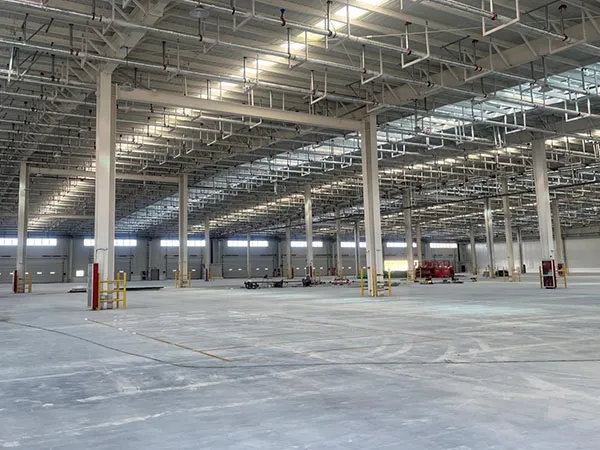Time:2025-11-15 02:28:28 Source:Sanjian Meichen Steel Structure
In the fast-paced logistics industry, warehouse performance relies heavily on efficiency, safety, and adaptability. As supply chains become more automated and data-driven, steel structure buildings have become the preferred choice for logistics centers worldwide. Their superior strength, long-span capability, and flexible architectural design make steel structures an ideal solution for companies seeking long-term scalability and cost-effective construction.
This article explores the key advantages of steel structure logistics centers, provides practical design recommendations, and outlines essential maintenance and safety strategies to keep operations running smoothly.
Steel structure buildings offer exceptional durability and adaptability compared with traditional concrete or brick facilities. Their greatest advantage lies in their ability to support large column-free spans, which are essential for:
High-density storage systems
Automated handling equipment
Large forklift turning areas
Heavy-duty racking and mezzanine floors
Because steel components are prefabricated and modular, logistics companies can expand or reconfigure their warehouses quickly with minimal interruption. This makes steel warehouses a valuable long-term investment for businesses with growing or seasonal demand.
Key Benefits:
High strength-to-weight ratio
Faster construction and lower labor costs
Excellent seismic and wind resistance
Easy expansion and remodeling
Eco-friendly and recyclable materials

Designing an efficient logistics facility begins with careful space planning and workflow optimization. Below are essential layout strategies to maximize productivity in a steel structure warehouse:
✔ Maximize Vertical and Horizontal Space
Steel structures support higher ceilings and wider clear spans, making it possible to integrate:
Multi-tier racking
AS/RS automated storage systems
Pallet shuttle systems
Mezzanine platforms
This significantly increases storage density without expanding the building footprint.
✔ Optimize Material Flow and Docking Areas
Smooth logistics operations depend on minimizing congestion. Consider:
Strategic placement of loading/unloading docks
Clearly defined forklift lanes
Dedicated zones for receiving, picking, packing, and shipping
Integration of conveyor systems or AGVs (Automated Guided Vehicles)
✔ Improve Energy Efficiency
Steel warehouses can be easily equipped with sustainable energy solutions:
Skylights and translucent panels for natural lighting
LED warehouse illumination systems
High-performance insulation
Energy-efficient HVAC
Solar roof systems
These features lower operating costs while creating a comfortable work environment.
✔ Build for Future Flexibility
The modular nature of steel structures allows flexible interior layouts. Using movable partitions and adjustable racking systems helps businesses adapt to:
Peak seasons
New product lines
Automation upgrades
Changing storage requirements
Proper maintenance ensures long-term performance and worker safety in logistics centers.
✔ Conduct Regular Structural Inspections
Check for:
Corrosion or rust on steel components
Loose or missing bolts
Roof leaks
Structural deformation from heavy loads
Early detection prevents costly downtime.
✔ Apply Protective Coatings
Enhancing durability with:
Anti-corrosion paint systems
Fire-resistant coatings
Galvanized steel components in high-humidity environments
These measures extend the lifespan of the building.
✔ Strengthen Safety Protocols
Key safety elements include:
Clear emergency signage
Fire suppression systems
Adequate ventilation
Anti-slip flooring
Automated monitoring or alarm systems
A safer warehouse improves worker productivity and reduces liability risks.
✔ Plan for Routine Technology Upgrades
Steel structures make it easy to retrofit modern equipment such as:
AS/RS automated storage systems
IoT smart sensors
Warehouse management systems (WMS)
Robotic picking solutions
High-speed sorting machinery

Q1: Why are steel structures ideal for logistics centers?
A1: Steel structures provide large column-free spaces, modular design flexibility, and faster construction compared to traditional materials, making them perfect for modern logistics operations.
Q2: How can a steel warehouse layout improve efficiency?
A2: Optimized steel warehouse layouts consider vertical storage, material flow, loading dock placement, and integration of automation systems to maximize space and productivity.
Q3: What maintenance is required for steel structure warehouses?
A3: Regular inspections for corrosion, structural integrity, protective coatings, and safety protocol updates are essential to prolong lifespan and ensure safe operation.
Q4: Can steel structure warehouses support automation technologies?
A4: Yes, steel warehouses are ideal for retrofitting with AS/RS, conveyors, IoT sensors, and robotic picking systems due to their modular and durable design.
Q5: How do steel structures contribute to energy efficiency in warehouses?
A5: They allow for high ceilings with natural light, integration of LED lighting, energy-efficient HVAC systems, and solar panels, reducing operational costs and carbon footprint.
Steel structure buildings provide modern logistics centers with unmatched efficiency, flexibility, and durability. Through intelligent design, optimized layout planning, and proactive maintenance, companies can significantly enhance warehouse productivity and operational stability.
For businesses looking to remain competitive in today’s fast-moving supply chain environment, investing in a steel structure logistics center is a smart strategic choice that delivers long-term operational and financial advantages.